Pasture Champions: Elfyn and Rhian Davies of Glancynin Farm, St Clears, Carmarthenshire, West Wales 2/2
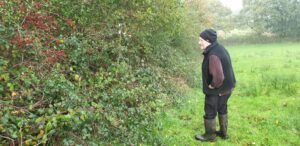 Elfyn Davies
Elfyn Davies
What do you do to encourage this biodiversity?
We’re not an intensive farm and we don’t push production; we try to keep everything in a natural balance. We don’t plough and we try to manage the sward sympathetically, trying not to poach and compact our heavy ground.
We moved from a slurry system to composting and this has helped the flora and fauna above and below ground. Over the years we have been involved in agri-environmental schemes which have funded the fencing of streamside corridors, woodland and orchard creation and management. We have farmed organically here for over 25 years, digging and creating the ponds, riverside corridors, planting the orchard and starting our hedgerow restoration.
We don’t flail our hedgerows but they are laid in the traditional, vernacular Carmarthenshire Flyer style, with mature trees fenced, left to grow, then harvested after some 15 to 18 years for firewood and wood chip.
This provides wildlife corridors and habitat, shelter for the cattle and food for the livestock and wild birds. We leave mature trees in the hedgerows and let the hedges grow up naturally. We leave bramble as part of the hedgerow and this acts as a cradle for saplings.
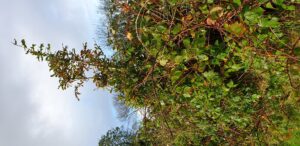 Sapling cradled by bramble
Sapling cradled by bramble
How is it connected across the farm and beyond?
Hedgerows and streamside corridors act as wildlife corridors, linking the farm and into the wider landscape.
Unfortunately, the surrounding farmland is quite sterile and the hedgerows have been lost or are managed by annual flailing.
It would be great to see improvements in hedgerow management and tree planting in the wider landscape to make the landscape more connected for wildlife.
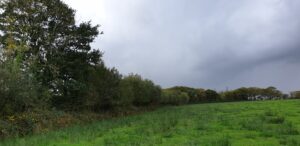 Hedge and browse line
Hedge and browse line
What are the benefits to the farm and is it increasing its climate and business resilience?
The benefits are unbelievable, particularly for the welfare of our livestock. We love every animal and their health and wellbeing is upper most in our thinking. They have a diverse diet of grasses, herbs, tree and hedgerow fodder and we try to build their immunity so we don’t need to use drugs to protect them, and use antibiotics only in extreme emergency cases.
When I came here I wanted to farm in a way that was appealing visually to us, to see the wildlife and care for it, but I didn’t realise the benefit to the cows at the time.
The hedges provide shelter from the sun, rain and wind and they love to browse the hedgerows, bringing them nutritional benefits.
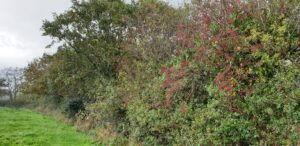 Berries in hedgerow
Berries in hedgerow
I wonder whether having these thick buffer zones in the form of streamside corridors and hedges means that the badger’s latrine is within them, because we don’t tend to have latrines in the fields. We’re lucky enough to be TB free in an area where it is rife.
The hedges sequester carbon as do our healthy soils; we compost our woodchip and straw manure, and return it to the land. The animals are healthy and therefore cost us little in veterinary and anti-parasite treatment.
There is also a benefit to me as a farmer, I love to spend time working on the farm, in nature, it helps with my mental health.
How do you monitor it?
I judge by eye and notice changes in my cattle. I don’t have any formal data, although I did have a bat survey carried out a number of years ago as part of an agri-environmental monitoring project.
Are there any benefits to the farm that are directly attributable to the Pasture for Life approach and/or would be lost if there were no ruminant animals on the farm? In brief, what are the benefits from having ruminant animals on the farm?
Cattle provide the home for the little insects like dung beetles; they feed the soil and keep it healthy. It is a holistic and sustainable approach to farming. We give the land a rest over winter and we put back what we take. The cows attract insects and provide hair for nesting mammals and birds. They cycle nutrients and provide nutritious, healthy food for local people.
What lessons have you learnt and would like to share with others?
I would like to encourage farmers not to chase production. Don't push animals hard, they will produce milk for you but won’t cost you extra in inputs.
Our cattle are an average of 11-15 years old and they’re happy and healthy. Don’t forget what they produce naturally will cost you very little to produce, otherwise you’re just buying production.
Value your hedges, they’re not wasted space, they’ll give you back far more than they cost you. I think that Pasture for Life certified farms should lead the way on hedgerow management.
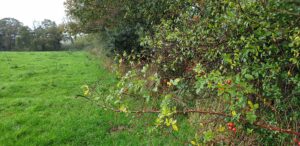 rosehips in the hedge
rosehips in the hedge
Leaving your hedges to grow and then laying them every 15-18 years will save you a lot more money in the long run, and retaining the ancient craft of hedge laying. Cattle keep the hedges trimmed back by browsing and they’re gaining nutritionally, using what is growing for free. By cutting back hedges every year, you create a sterile environment for wildlife and you’re wasting carbon capture potential.
Since transitioning to PfL three years ago, and therefore ceasing feeding soya to the cows, I’ve noticed that they are much healthier, happier and calmer. They’re eating what they’re designed to eat, which is grass, herbs, shrubs and trees.



